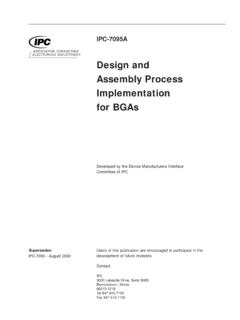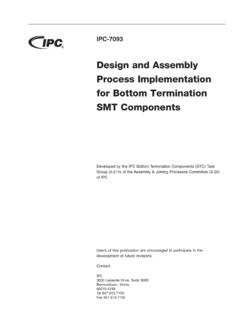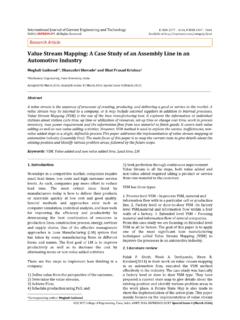Transcription of MECHANICAL ENGINEERING DESIGN PROJECTS …
1 MECHANICAL ENGINEERING DESIGN PROJECTS . FINAL STATUS REPORT. SUBMITTED BY. Bennett Lee | Ethan Aaron | Mike Steltenkamp Group #9. May 6, 2013. 1|P a ge MECHANICAL ENGINEERING DESIGN PROJECTS . FINAL STATUS REPORT. TABLE OF CONTENTS. project OVERVIEW .. 3. OVERALL 4. TESTING/PROTOTYPING 4. PROPOSED IMPROVEMENTS/LESSONS LEARNED .. 14. REQUIREMENTS COMPLIANCE .. 18. COST .. 22. 2|P a ge MECHANICAL ENGINEERING DESIGN PROJECTS . FINAL STATUS REPORT. project OVERVIEW. Provide a short technical summary of your project and again describe the problem/challenge you are addressing. Problem at Hand According to the World Health Organization, approximately billion people do not have access to safe drinking water around the globe.
2 There is a clear need for a household filtration system that can be implemented and maintained at extremely low costs. HydraVita System In 2010, a group of Penn ENGINEERING students started the development of the HydraVita system by turning research from a Stanford University publication into the first prototype of an integrated water-sterilization device. Throughout the year, the team constructed a solar power source as well as a water filter that was able to inactivate up to 81% of the bacteria passing through the system. Through the use of extensive bacteria inactivation testing, product DESIGN analysis, and DESIGN for manufacturability techniques, our team has improved and optimized many critical aspects of the HydraVita system.
3 Not only have we been able to realize significant cost-reductions, increase ease-of-use, and improve ease-of-implementation, but we were also able to reach inactivation rates up to 88% with our final device and inactivation rates upwards of 99% during configuration testing. Our HydraVita system incorporates novel technology integrated with low-cost components and extensive empirical testing to provide a household filtration system that is on the cusp of implementation in developing nations. project Metrics Superior reliability and robustness compared to previous HydraVita device Optimized CNT/AgNW filter DESIGN based on empirical results (bacteria testing).
4 Low total device cost of under $100. Proven ability to reach inactivation rates of over 90% consistently Achievable flow rate of 80 liters per day that allows for enough clean water to support a family of four (given necessary water pressure). Minimal number of components for assembly and serviceability Low cost and compact turbidity filter cartridges that can be replaced in the field without the use of any tools Include LED indicators to acknowledge current flow Minimize turbidity while not slowing down the overall flow rate of the device Function for one month of standard usage without any maintenance 3|P a ge MECHANICAL ENGINEERING DESIGN PROJECTS .
5 FINAL STATUS REPORT. OVERALL DESIGN . Summary of DESIGN While select communities in developing nations have community water treatment systems, or new technologies such as the LifeStraw line of products that allow for smaller quantities of water to be filtered for personal use, there is a further need for a household filtration system that can be implemented and maintained at extremely low costs. In developing such a device, there are five key parameters upon which the DESIGN must focus: (1) bacteria inactivation rate, (2) cost, (3). ease of use, (4) power consumption, and (5) ease of implementation. Through the use of extensive bacteria inactivation testing, product DESIGN analysis, and DESIGN for manufacturability processes, our team has improved and optimized many critical aspects of the HydraVita system, creating a low cost product that is very close to being ready for deployment in third world countries.
6 Underlying Technology Our water sterilization system is based on technology that was originally published by the Yi Cui Group at Stanford University. By applying a voltage bias across a cotton filter embedded with carbon nanotubes and silver nanowires, high inactivation rates and high flow rates can be achieved. This innovative technology kills bacteria using three processes: A process known as electroporation that breaks down cell membranes The antimicrobial properties of silver Changes in the chemistry of the solution such as pH. levels Because our system is killing bacteria as opposed to catching or blocking them, it allows for high-speed water filtration while only requiring minimal power usage.
7 Scanning Electron Microscopy Images of Filtration Technology 4|P a ge MECHANICAL ENGINEERING DESIGN PROJECTS . FINAL STATUS REPORT. Scanning Electron Microscopy (SEM) images showing cotton fibers, silver nanowires, and carbon nanotubes within the HydraVita system. From left to right, the images show (1) the cotton fibers within the filter, (2) silver nanowires protruding from a single cotton fiber, and (3) carbon nanotubes and silver nanowires embedded in the cotton matrix. These images were taken at the Penn Regional Nanotechnology Facility in April of 2013. System Schematic 5|P a ge MECHANICAL ENGINEERING DESIGN PROJECTS .
8 FINAL STATUS REPORT. Functional Block Diagram Functional Characteristics Bacteria Inactivation: Bacteria inactivation testing was an essential part of the DESIGN and development processes for the HydraVita device. Given the extreme importance of increasing the bacteria inactivation rate, we focused a significant amount of time testing key DESIGN parameters throughout the year. In particular, we inoculated bacteria, conducted filtration tests, and cultured bacteria in order to optimize: (1). electrode configuration, (2) filter fabrication method, (3) cross-sectional area, and (4) filter density. Through extensively planned and precisely executed parameter testing in the lab, we were able to reach bacteria inactivation rates in the laboratory upwards of 99%.
9 Cost Reductions: Over the course of this year, we have designed major cost reductions into the HydraVita system through the use of low-cost PVC components and a more simplistic DESIGN . By utilizing DESIGN for manufacturability techniques, we have focused on reducing material costs, improving assembly times, and creating a device that can be serviced at a low cost over its lifetime. The new DESIGN not only boasts lower upfront costs, but also minimizes maintenance costs for the end user. 6|P a ge MECHANICAL ENGINEERING DESIGN PROJECTS . FINAL STATUS REPORT. Modularity of Device: In addition to lower costs, the modular DESIGN of the HydraVita system allows for improved ease-of-use, which is critical for implementation in developing nations.
10 While the filtration technology underlying the product is on the cutting edge, it should not be difficult for users to understand and access the turbidity filter and interior of the device for cleaning and maintenance. By taking advantage of the water-tight press-fit seal of PVC, the HydraVita system remains robust, while modular at the same time. Point-of-Use Diagnostics System: Not only does the HydraVita system produce promising bacteria inactivation rates at a low cost, but it now includes a diagnostics system in order to alert users when the filter is malfunctioning. We have implemented a simple but reliable circuit that powers a red LED when voltage is detected from the power supply, and switches to a green LED light when current is actually running through the CNT/AgNW filter.




